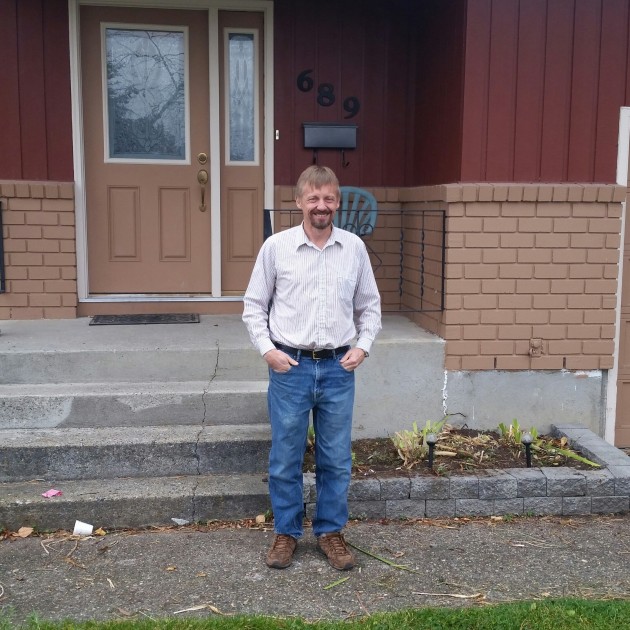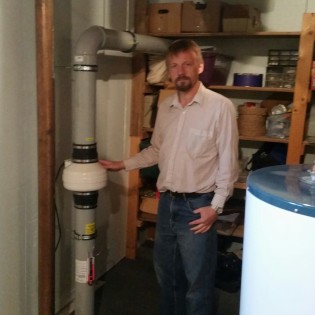Homeowner Takes Action to Prevent Radon Exposure
Prince George, B.C. – A recent report presented to Prince George City Council detailing the presence of radon in the city was no surprise to Dennis Fudge.
In fact the issue has been on his radar for several years dating back to when he first tested his ‘bowl’ area home (the report revealed more than half of the homes in the “V2M” area code have high radon levels. For more information click here).
“I started six years ago when I left a monitor here for a year just to see what the values were,” says Fudge. “Health Canada recommends to be below 200 becquerels per cubic metre (BQ/m3) and the highest value I had at the time was about 678.”
Following the high radon reading he made mitigation his mission.
(Radon is a naturally occurring, colourless, odourless gas caused by the breakdown of uranium in soil and rocks and is the third leading cause of Lung cancer).
“I patched a few 6×6 square holes in the foundation. I sealed those up, I sealed some of the cracks and then I monitored again for winter and it was still high but about 490 Bq/m3,” he says.
“I purchased a continuous monitor (Pro3 Series) which provided weekly average values on the monitor display and tried to determine any areas where higher levels of radon existed in the basement.”
Fudge says it wasn’t until he purchased a pump that radon levels began to drop substantially.
“It caused the levels to drop about 90% or more but it is expensive to install,” he says. “It could go from $1,800-$2,400 depending on the size of the pump you need.”
Fudge says if spending roughly $2,000 isn’t in your budget, there are “tricks to the trade” one could employ to help out.
“If I open the windows on a breezy day the wind would come through and the radon numbers in the basement would drop right down or stick a vacuum hose through the window to suck the air from outside into the basement for a couple of hours and that made a difference.”
Regardless, he says all the effort has been worth it noting “you’ve got to know what you’re breathing in.”
Since then, Fudge says he’s been trying to spread the word about the importance of getting tested.
“I’ve been trying to persuade the Prince George School Board to get tested and they decided they didn’t think it was a need because numbers were low 25 years ago,” he says.
“But anybody knows over time you get cracks developing in buildings, wear and tear and just because it was low 25 year ago doesn’t mean it’s low now.”



Comments
So much for reducing the carbon foot print in new homes, the vapour barrier seems to have not worked and the real reason for this is the finishers sliced it open so the concrete would set up earlier so how could it not fail. Simple epoxy paint a proven to greatly reduce radon at cost of about 1000 dollars and no carbon foot print.
The Canadian Building Digest is published by the National Research Council with the primary audience being building professionals such as Architects, Engineers, building inspectors, including organizations such as CMHC, various Homebuilder Associations across Canada and, of course, those who develop the National Building Code as well as those who may add restrictions on a provincial basis for provincial codes.
In February 1988 they published CBD-247 “Control of Radon in Houses”
web.mit.edu/parmstr/Public/NRCan/CanBldgDigests/cbd247_e.html
It took 22 years to get the dangers of radon in low rise housing to be seriously considered and its mitigation designs written into the National Building Code. From there, the Provincial Building Codes eventually made changes.
I find the fact that there is no good quality professional help to assist people to understand not only who is at risk, but also how to mitigate that risk for those people, both for existing housing as well as new housing.
Dennis Fudge is a scientist and tested the results of implementing several approaches. That is not something that most people will or can do.
This is an environmental problem that we have known about for a long time with little action by those people who were in a position to have that knowledge and in a position to have done something about it. But they did not for several decades.
I find the “help” we are getting right now to be totally inadequate. I know of several methods to tackle the problem for those who have it. Building houses that are more airtight over the last 20 years has not helped the situation. We need better access to the surveys that have been done and what data they actually collected. We need better formal research such as what Dennis Fudge did on his own, and that information shared based on the age of the dwelling unit, location, location of the measurements in the unit, weather, time of year, etc.
Give us something to be aware about as far as mitigation efforts. Treat this the same as assistance provided by government to reduce energy consumption. If radon is such a large causative factor for lung cancer, there will be offsetting cost savings to the medical safety net.
That sentence in my previous post was supposed to read:
I find the fact that there is no good quality professional help to assist people to understand not only who is at risk, but also how to mitigate that risk for those people, both for existing housing as well as new housing to be inexcusable.
“Simple epoxy paint a proven to greatly reduce radon at cost of about 1000 dollars and no carbon foot print.”
Can you point me to the research on that, please?
The US EPA states that radon ions pass through plastic barriers such as polyethylene, for instance.
Also, no one has told us anything yet about radon in our water supply. Our water comes from wells rather than from surface water, thus should be tested. Can someone tell us whether there is radon in our water and, if so, how much?
Do you have granite countertops ? Freshly cut on six sides . They are also a source of radon gas .
So is Gypsum Board.
It is the “daughter” ions which are actually the culprits. They “plate out” (attach) to surfaces which have an opposite charge.
One of the “surfaces” are particles in the air, such as those that we get outside on bad air days, such are normal dust in the air, such as road dust, especially if you are living in rural areas with unpaved roads, etc.
So, electrostatic air filters can help to get rid of fine particles in the home with forced air systems.
That is the reason why smokers who live in radon rich dwelling units get a double whammy – the ions plate out on the smoke which is inhaled into the lungs not only by the smokers but also by second hand smoke.
Comments for this article are closed.